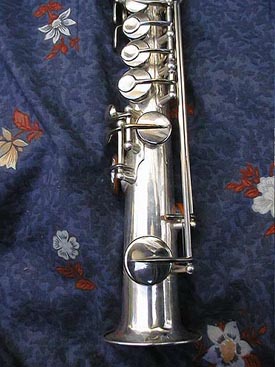The Buffet Early Evette & Schaeffer

- There are three "subsets" of horns produced during this period:
- Low B models:
These models, functionally and visually identical to earlier horns, were available (probably) as the low-cost or "introductory" line. Couesnon, Sax and other French-manufacturers also sold their low B horns as low-cost models, so I'd say this was standard practice (pun intended. SML revised this practice of selling the older model along with the newer one in the 1940's with their Standard model). HOWEVER, these horns may have been A=435hz horns (French standard pitch) and discontinued "around" 1914 when the A=440hz (low pitch) international standard was introduced.
- Non-patented models:
These are essentially an evolution of the earlier series of horns and have improved keywork and extended keyed range (see below). They just don't have any of the alternate keywork that the patented models have.
- Patented models:
Paul Evette and Ernest Schaeffer bought the Buffet-Crampon firm in 1885 and patented their first saxophone on July 25, 1887 (December 5, 1899 in the US). These horns are significantly different than earlier models and are possibly the most technically advanced of any French-made horn produced at the time, with the possible exception of Couesnon.
Instrument Features
- All horns had the following features:
- Updated engraving featuring the Buffet-Crampon logo and the Evette & Schaeffer name. The importer's name, generally either "Carl Fischer, New York" or "HN White, Cleveland" (HN White, the manufacturer of the King saxophones, imported these horns as their saxophone line until approximately 1908) is only engraved on horns exported to other countries.
- Double or "split" octave key. In approximately 1916 the automatic octave key became standardized (it was an "additional cost" option before this). Low B models probably never gained the automatic octave key.
- Roller keys. Most low B models do not sport this feature.
- Horns available in both low pitch, A=440hz and high pitch, A=457hz. See my comments regarding LP vs. HP instruments HERE.
- Some horns are engraved "Conn" to avoid import taxes into the US. (Some Conns were engraved "Buffet" to avoid export taxes to France, so I guess it all works out :)
- All models except the Low B horns introduced the following:
- A keyed range that extends from low Bb to high F on alto, C melody and Bb tenor. Keyed range extends to low Bb to high Eb on soprano, baritone, bass and contrabass models.
- A front altissimo F key is available on Eb altos and Bb tenors.
- C horns (melody tenor and soprano models) in approximately 1920. These horns are very uncommon, as France never had the same fascination with C horns that the US did.
- Contrabass models around 1920. These were only custom made and very few were produced -- it's theorized that somewhere between six and 20 sitill exist. (Take a look at my SOTW article regarding a performance that included one of the few surviving Evette & Schaeffer contras.)
- Baritone models that no longer had a fixed neck.
- Pearl keywork, in the mid 1920's. They don't appear to be "standard fare" until the 1930's.
Keywork Changes
The patented horns introduced some interesting keywork changes:
"The 1920 Buffet soprano is an interesting horn. Notice two things: all the right hand keys (D, E, F) can be held down with the third (D key) finger alone, leaving the first and second fingers free to engage alternate RIGHT HAND touchpieces for the low Bb and B. These right hand levers are suspended above the E and F keys. A variation of this key system was available later on Evette & Schaeffer saxes and called the APOGEE system."1
Below is a copy of an 1899 advertisement for these horns (click the image to view it full size). I've made the text a little more legible (you can see the original HERE). It gives you a very good idea of what the additional keywork is for. (See also the Vintage Saxophones Revisited article by Prof. Paul Cohen in the March/April 1994 Saxophone Journal magazine.)
